An allergic rash is the appearance on a person’s skin of various changes that differ appearance and color from the rest of the skin. The rash is often accompanied by itching and redness.
The manifestation of an allergy can be either a local reaction of the skin to an external irritant, or indicate some kind of internal disease.
When examining a patient, the main thing for a doctor is to distinguish an allergic reaction from the symptoms of the disease in order to prescribe appropriate treatment.
Forms of manifestation
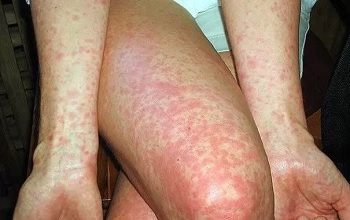
A rash is the first sign of an allergy, and the place of its occurrence on the body can be anywhere.
A small area of skin may be affected, and the rash may spread throughout the body.
In addition to itching and burning, peeling spots and swelling are sometimes observed. Inflammations may become weeping over time.
Allergic rashes come in different forms:
- blisters;
- bubbles;
- spots;
- papules;
- ulcers;
- erosion formations.
The type of rash depends on the cause that caused it and the stage of the disease.
In the form of hives
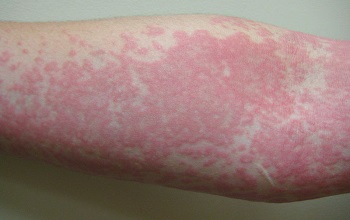
Urticaria in appearance resembles the burns left by nettles. This many blisters on the skin, which are very itchy and can grow to large sizes.
This allergic-toxic disease develops due to exposure of the body to external allergens or ingestion of products that provoke an allergic reaction.
Urticaria can be not only one-time, but also permanent if the rash appears on the skin regularly.
Developed Quincke's edema
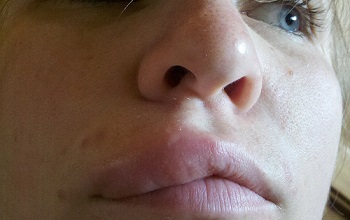
Swelling of the skin and mucous membranes is called angioedema, which can affect the eyelids, cheeks, lips, larynx and, in some cases, the genitals.
In the area of edema, pain and burning, sometimes itching, are felt.
This dangerous disease, especially if swelling has formed in the larynx, which can lead to suffocation. The appearance of edema is accompanied by a change in complexion to a bluish tint.
A patient with Quincke's edema urgently hospitalized.
Eczema
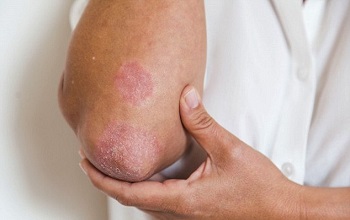
This disease is recognized by red rough spots, rough to the touch and causing quite severe itching.
As the disease progresses, eczema worsens the condition of rashes that break out and leave on the skin erosive spots. These formations begin to peel off and get wet.
Foci of eczema spread very quickly, in most cases affecting a person's face and hands. In rare cases, eczema appears on other parts of the body.

Atopic dermatitis appears immediately after contact with allergens in individuals with increased level sensitivity to them.
This forms on the skin itchy vesicles that cause pain.
Dermatitis can lead to pyoderma if the affected areas become infected.
Causes of allergic rash. List of major allergens

According to statistics, more than a quarter of the population of developed countries suffers from various types of allergies.
The number of people susceptible to this disease is constantly increasing.
The causes of allergies are constant environmental deterioration and noticeable changes in diet modern man. The more often a child comes into contact with possible allergens from childhood, the stronger his immunity to them develops.
The list of main allergens includes:
- Food;
- mites;
- mold;
- chemical substances;
- insect bites;
- animals;
- cosmetics;
- pollen;
- cold;
- medicines.
External medications
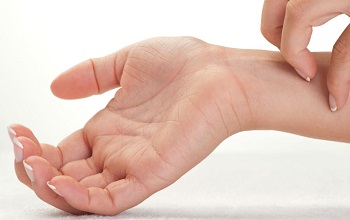
An inflammatory rash on the body can be caused by skin reaction to various irritants, for example on external medications.
It appears at the site of application and usually does not spread to other areas.
If an allergy is confirmed, the doctor must adjust the treatment in accordance with the characteristics of the patient’s body.
Cloth
![]()
Allergies to clothing can occur for various reasons.
For example, a person may have increased skin sensitivity to mechanical friction clothing or substances that were used in the production of a particular item.
Often, to obtain the desired color and texture, manufacturers use fixatives, dyes and resins, which irritate the skin person.
Some people may have an allergic reaction to cotton fabric because cotton is grown chemicals are used, which are difficult to remove even with careful processing.
Perfumes and cosmetics
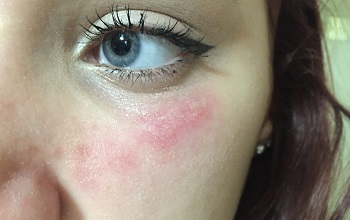
Allergy to cosmetical tools manifests itself as dermatitis, which occurs immediately or several hours after applying cosmetics or perfume to the skin.
Most often the reason is individual feature body or sensitive skin.
In most cases, you have to give up the cosmetics that caused the reaction.
Household chemicals
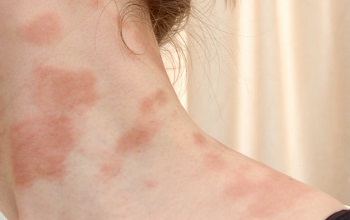
An allergic reaction to household chemicals is easy to diagnose. This is a contact type of allergy, the symptoms of which quickly disappear after avoiding contact with the allergen.
Contact dermatitis from household chemicals appears in the form of outlined fields at the points of contact with the component that caused the reaction.
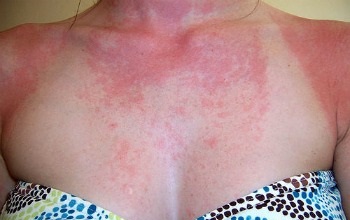
Signs allergic reaction in the sun vary depending on the causes and age of the person.
Most often this is redness and itching of the skin in areas that have been exposed to the sun.
A healthy person should not be allergic to the sun. It most often occurs in infants, the elderly, and people with a chronic disease.
Contact with varnishes and paints

Symptoms of an allergy to paints and varnishes manifest themselves in a special way.
A person begins to experience nausea, dizziness, pain in the eyes, watery eyes and a runny nose. A rash appears.
In this case, doctors prescribe antihistamines to release chemical elements from the body.
Interaction with toxic substances
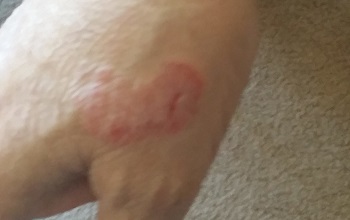
When interacting with toxic substances, intoxication of the body is possible, which will damage the skin.
Intoxication provokes dermatitis, which affects certain areas of the skin.
When treating, it is imperative to first eliminate the cause of toxins entering the body.

A metal allergy is not necessarily associated with a predisposition to it.
After prolonged contact with the skin, ions of any metal begin to penetrate through the upper layer into the body.
As a result, an allergic reaction occurs, which can be eliminated by stopping wearing jewelry made from a certain type of metal.
The body's reaction to insect bites
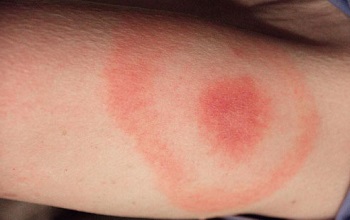
Symptoms of a sting allergy can occur individually or together.
These include difficulty breathing, redness at the site of the bite and itching, swelling of the throat and face, rapid pulse, low blood pressure and dizziness.
This is a dangerous allergy that can lead to shock and loss of consciousness.
An acute reaction to insect bites requires emergency medical care.
Eating allergens

External signs of a food allergy appear within a few minutes after ingestion of the allergen.
These include abdominal pain, vomiting and diarrhea, skin rashes, and swelling of the lips.
Children's food allergies manifest themselves diathesis.
Most people can recover from food allergies by following a strict diet. However, allergies to fish, peanuts and shellfish most often remain for the rest of life.
Individual intolerance to certain drugs
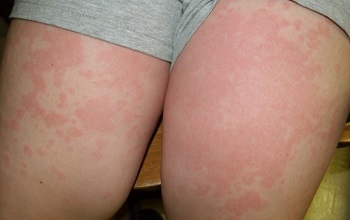
An allergic reaction to a medicine can appear either within an hour after taking the drug, or within two days after taking it.
In case of severe intolerance to the drug, it is necessary to discontinue it and carry out treatment, which includes drugs with antihistamine properties.
If the reaction is weak, and discontinuation of the drug is extremely undesirable, the doctor may prescribe the combined use of the drug and an antihistamine.
Intolerance to the drug is manifested by urticaria, rhinitis, and an attack of bronchial asthma.
Gastrointestinal poisoning
![]()
In most cases, gastrointestinal poisoning is caused by the proliferation of E. coli and Staphylococcus aureus in foods.
Severe poisoning can be caused by both products that have expired and those that were not stored in accordance with appropriate conditions and sanitary standards. Poisoning can often be caused by poisonous plants and mushrooms.
For treatment gastric lavage and absorption of absorbents are used.
The body's response to stress factors

Prolonged stress can lead to allergies.
This is a consequence of decreased immunity, in which the body releases certain chemicals and hormones that cause allergic symptoms.
Herself stressful situation cannot cause an allergy, but can only increase the level of histamines in the blood and aggravate its symptoms.
Features of treatment
Treatment of allergic diseases is always comprehensive and consists of several methods of influence.
These are measures aimed at eliminating the acute process, carrying out preventive measures, and basic therapy measures.
After stopping contact between a person and the allergen, you should try to exclude its reoccurrence. Avoiding allergens is the main method of treating allergies and is highly effective.
Rash all over the body

The appearance of various skin changes on the human body indicates a malfunction in the body. Most often it is expressed by an allergic rash, which occurs as a result of contact with external or internal irritants.
Additionally, a rash on the body may be accompanied by an increase in body temperature.
On hands
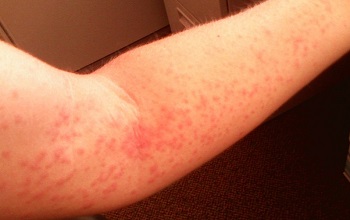
A rash on the hands is most often caused by contact with a chemical element. For example, a detergent that contains chlorine.
Also, an allergic rash in the hand area may appear after exposure to cold air due to dry skin. In some cases, these drugs cannot be used, for example during pregnancy. Therefore, to eliminate the symptom, they may be offered ethnoscience includes the preparation of antiallergic alcohol tinctures, mixtures and decoctions. Most often they are used to make lotions for affected areas, but sometimes tinctures need to be taken orally in doses.
Folk remedies give good results when combined with modern methods of combating allergies.
Herbs such as string, viburnum and chamomile are effective. All of them relieve inflammation and have a quick effect.
Local impact
A number of topical medications are suitable for both children and adults. These are creams, ointments and gels that have a regenerating effect on the skin, have an anti-itching and anti-inflammatory effect. Thanks to topical medications, you can quickly relieve unpleasant allergy symptoms.
Ingestion
In combination with medications that need to cover the affected areas of the skin, in most cases medications are prescribed for internal use. In addition to tablets, these can be herbal decoctions and inhalations with special oils that have an antiallergic effect.
Prevention
After identifying the substances that cause an allergic reaction, you should try to avoid any contact with them.
For example, if you are allergic to dust, you need to do wet cleaning often; if you are allergic to pets, you should not keep them in the house. If a person is allergic to certain medications, this should be recorded in their medical record. You should also notify close relatives and friends if you have a reaction to a particular product. People with allergies to certain foods will have to choose those foods that their allergist recommends.
Allergic rash on the human skin can appear due to various dermatological diseases, which can be a consequence of an allergic reaction. This is due to the excessive sensitivity of the skin to external and internal irritants. Such irritants are often medications, food products, fabrics, pollen, pet hair and much more.
Causes of skin allergies in adults
There are a large number of allergens that can trigger an unwanted skin reaction. This, in turn, is the cause of the development of allergic dermatosis.
Many experts believe that the number of allergy sufferers has begun to increase rapidly due to unfavorable changes in the environmental situation and due to the consumption of genetically modified products.
In addition, various cosmetics contain haptens, which can also trigger skin allergies.
Skin rashes can be caused by the following allergens:
- Household dust.
- Chemistry.
- Cosmetics.
- Medications.
- Food.
- Personal hygiene products.
- Pet fur.
- Pollen.
The mechanism of skin allergies
The main factor in the manifestation of allergic dermatosis is considered to be any allergen- a substance with a molecular structure that is of protein origin.
It happens that allergens can be various elements that do not provoke an immune response when they penetrate the blood. Particles that are carried by antigenic determinants are called haptens. These elements can bind to tissue proteins. Haptens are found in medications and other chemicals.
If an allergen or irritant enters the human body, sensitization begins to develop, which subsequently leads to excessive sensitivity of histamine receptors. This action is explained by the formation of antibodies or the synthesis of sensitized leukocytes.
An allergic rash on the skin of an adult forms at the stage of pathophysiological development of the disease. At this time, mediators of the pathological process are able to affect normal skin cells, provoking an inflammatory process.
Itching
In most cases, skin allergies can be accompanied by itching of varying intensity. The main causes of itching are external and internal allergens.
The body begins to perceive such allergens as dangerous, which results in an allergic reaction in the form of itching. There are several main allergic skin diseases that can be accompanied by itching. These diseases are described below.
Allergic rashes in adults
It is also worth noting that allergies can simply be expressed by rashes on the skin without the presence of itching. However, an allergic rash may look different, depending on the disease itself.
Features of an allergic rash:
- The rashes do not have a clear shape.
- The spots have blurred edges.
- The color of the spots can range from pink to dark red.
- The rash may be accompanied by mild swelling.
- Sometimes peeling appears.
- The rashes can be localized throughout the body, depending on the type of allergy.
- The rash may take various types: spots, nodules, blisters, blisters.
Types of allergies
The appearance and characteristics of skin rashes depend on the type of allergic dermatosis. The rash can appear either on a separate area of the body or be localized throughout the body.
That is why in medicine there are several main types of allergic reactions:
- Atopic dermatitis.
- Contact dermatitis.
- Hives.
- Eczema.
- Toxidermy.
- Neurodermatitis.
- Quincke's edema.
- Lyell's syndrome.
- Steven-Johnson syndrome.
Atopic dermatitis
Atopic dermatitis is an individual skin disease that is not transmitted by contact. Atopic dermatitis is prone to complications and relapses, so this disease must be constantly monitored, like any other type of allergy.
Symptoms of atopic dermatitis:
- Skin itching.
- Dry skin.
- Skin irritation.
Atopic dermatitis can cause discomfort, psychological instability, loss of performance, bacterial infection of the skin.
Atopic dermatitis can be triggered by the following factors:
- Dust.
- Insect bites.
- Pet fur.
- Pet food.
- Medications.
- Unfavorable environmental conditions.
- Food.
Photo of atopic dermatitis
![]()
Contact dermatitis
Contact dermatitis– this is one of the types of allergic inflammation of the skin, which manifests itself after skin contact with an external allergen or irritant. If a person has hypersensitivity to an allergen, contact dermatitis develops quickly, however, there are cases when this allergic disease can develop over several weeks.
Symptoms of contact dermatitis:
- Redness of the skin.
- Swelling of the area of skin that came into contact with the irritant.
- Bubble formation.
- Rashes.
- Formation of erosion.
Contact dermatitis can occur when the skin is exposed to the following factors:
- Food.
- Cosmetical tools.
- Chemicals used in everyday life.
- Metals.
- Medicines.
- Clothes made from synthetic fabrics.
Photo of contact dermatitis
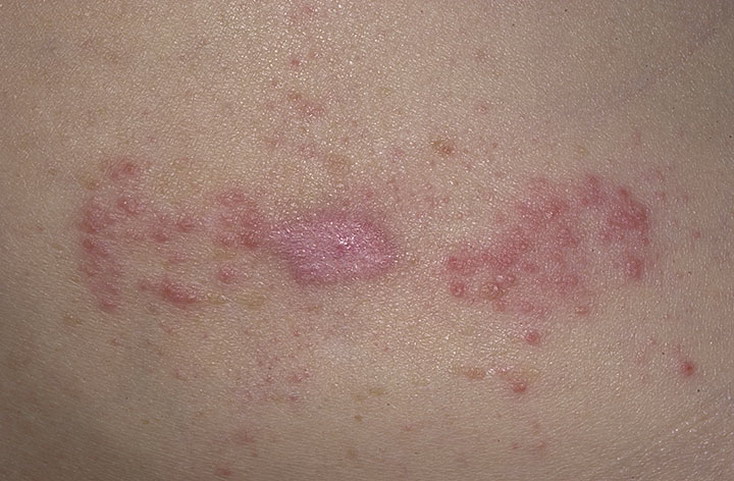
Hives
Urticaria is a very common skin disease that involves the formation of local swelling and blisters, accompanied by severe itching.
Symptoms of urticaria appear only after contact with an external or internal irritant and are as follows:
- Formation of blisters, the size of which can be 5 mm.
- The color of the blisters is pink or red.
- Cardiopalmus.
- General weakness.
- Swelling of the skin.
- Sometimes there is a burning sensation.
- Dizziness.
After the blisters disappear, no marks remain on the body. As for the causes of urticaria, only 5% of them are allergic.
The main ones should be highlighted:
- Presence of a viral infection.
- Insect bite.
- Blood transfusion.
- Stress.
- Cold.
- Sun rays.
- Tight clothes, woolen items.
Photo of hives
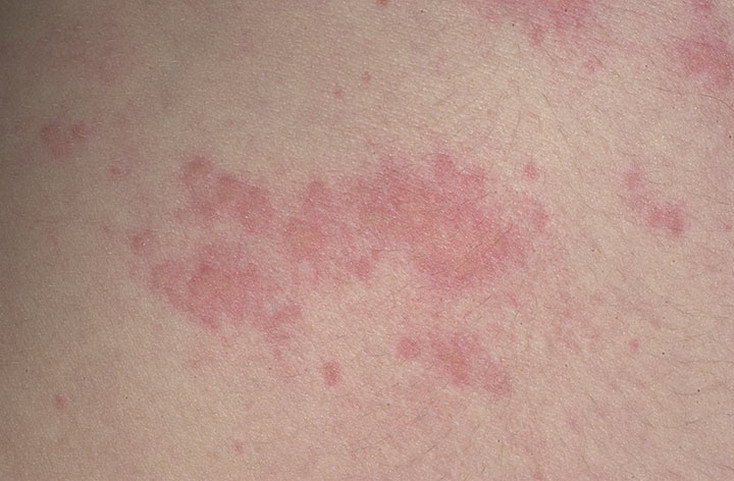
Eczema
Eczema commonly called a dermatological disease that affects the upper layers of the skin. This skin pathology is allergic in nature. Eczema appears literally anywhere, but is mainly localized on the hands and face. This allergic skin disease can develop in anyone, regardless of age and gender.
Main symptoms of eczema:
- Acute inflammation.
- Numerous rashes.
- The appearance of small point erosions after opening.
- Serous fluid in formations.
- Severe itching.
It is worth noting that eczema can be complicated by secondary infection.
Causes of eczema:
- Endocrine system disorder.
- Stress and depressive disorders.
- Metabolic disorders.
- Food allergic reaction.
- Household dust.
- Pollen.
- Allergic reaction to household chemicals.
- Using cosmetics that provoke the development of allergies.
Photo of eczema

Toxicoderma
Toxicoderma often called toxic-allergic dermatitis. This disease is characterized by an acute inflammatory process that spreads throughout the skin. Sometimes the mucous membranes are also affected. Most often, toxicoderma develops on the basis of side effects after taking any medicines.
Symptoms during the development of toxicoderma can be varied, because it depends on the type of disease
However, some common ones can be identified:
- Rashes on the skin.
- The color of the rash is pink or red.
- Inflammations of different sizes.
- Blistering.
Causes of toxicoderma:
- Medications.
- Food.
- Interaction of chemicals.
Photo of toxicoderma
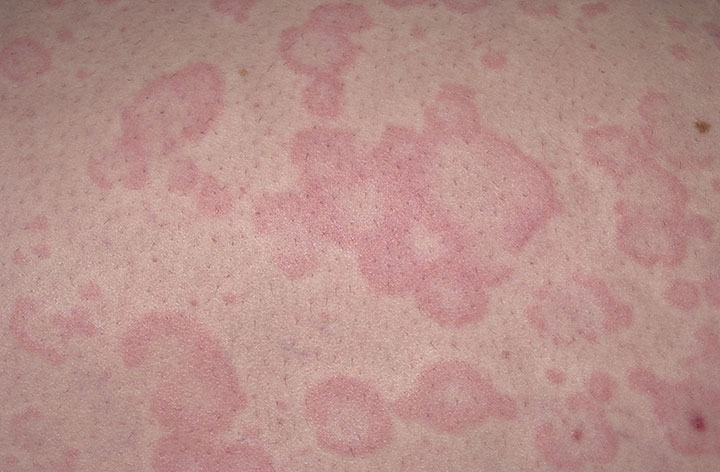
Neurodermatitis
Neurodermatitis is a skin disease characterized by tissue inflammation. In most cases, neurodermatitis begins to develop against the background of an allergic reaction. However, in addition to this, there are a number of other factors that can provoke the development of this disease.
Symptoms of the development of neurodermatitis:
- Itching that gets worse at night.
- Rashes in the form of red spots.
- Formation of plaques that can merge with each other.
- Formation of bubbles with liquid contents.
- Swelling.
The main causes of neurodermatitis:
- General weakening of the immune system.
- Intoxication of the body.
- Inflammation of the skin.
- Metabolic dysfunctions.
- Presence of gastrointestinal diseases.
- Heredity.
- Physical exhaustion.
- Poor nutrition.
- Wrong daily routine.
- Stress, depression.
Photo of neurodermatitis
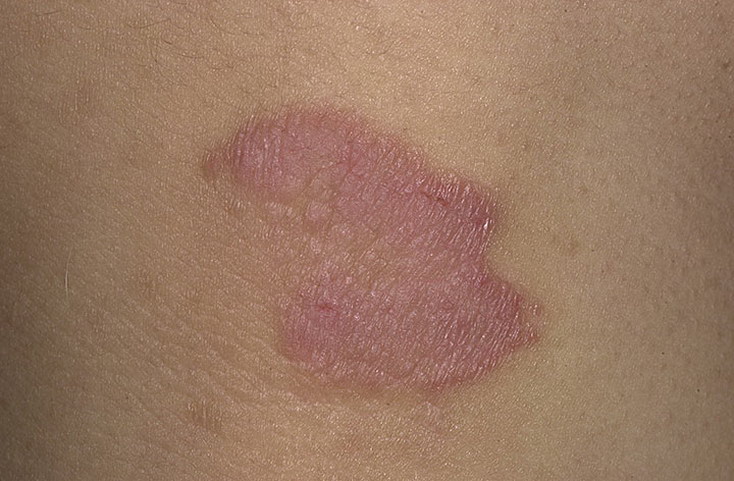
Quincke's edema
Quincke's edema called local swelling of the mucous and fatty tissue. This disease occurs suddenly and is characterized by its rapid development.
Quincke's edema most often develops in young people, mainly women. Swelling occurs on the principle of a common allergy. In most cases, Quincke's edema is combined with urticaria, expressed in acute form. Most often, this disease is localized on the face.
The main symptoms of Quincke's edema:
- Swelling of the airways.
- Hoarseness.
- Difficulty breathing.
- Cough.
- Swelling of the lips, eyelids, cheeks.
- Swelling of the oral mucosa.
- Swelling of the genitourinary organs.
- Acute cystitis.
Causes of Quincke's edema:
- Allergic reaction to food.
- Dyes and artificial additives in food.
- Pollen.
- Pet fur.
- Feathers.
- Insect bites.
- Regular dust.
Photo of Quincke's edema
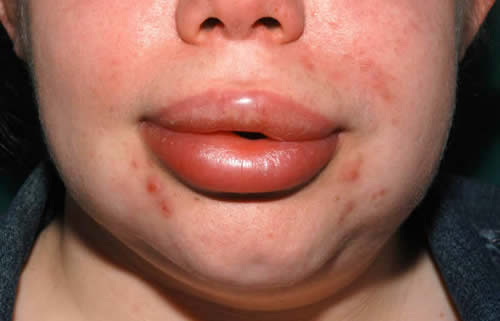
Lyell's syndrome
Lyell's syndrome This is the most severe form of allergic reaction to medications. This disease is characterized by severe dehydration, toxic damage internal organs and development of the infectious process. Lyell's syndrome is very dangerous and can be fatal if you do not seek help in a timely manner.
Symptoms of the development of Lyell's syndrome are very similar in appearance to 2nd degree burns, as they are characterized by:
- The appearance of wounds on the skin.
- Formation of cracks in the skin.
- Bubble formation.
Causes of Lyell's syndrome:
- Antibacterial agents.
- Anticonvulsant drugs.
- Anti-inflammatory drugs.
- Painkillers.
- Drugs to combat tuberculosis.
- Use of dietary supplements and drugs that enhance immunity.
Photo of Lyell's syndrome
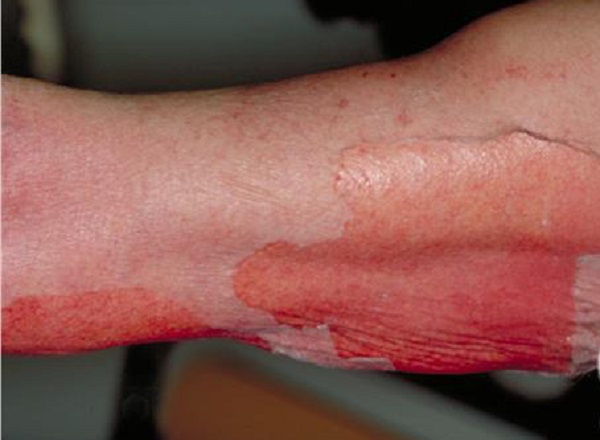
Steven-Johnson syndrome
Steven-Johnson syndrome is a form of exudative erythema multiforme, which is characterized by inflammation of the mucous membranes and skin.
This disease has a very severe course. Most often, Steven-Johnson syndrome affects people over 40 years of age, however, cases of the disease have also been recorded in young children. In the first stages, the disease affects the respiratory tract.
Symptoms of Steven-Johnson syndrome:
- Fever.
- General weakness.
- Cough.
- Headache.
- Joint and muscle pain.
- Vomit.
- Diarrhea.
- Rashes on the skin.
- Swelling of formations.
- The rash is red.
- Burning.
- Skin lesions bleed.
Causes of Steven-Johnson syndrome:
- Existing infectious diseases.
- Allergic reaction to medications.
- Malignant diseases (cancer).
Photo of Steven-Johnson syndrome
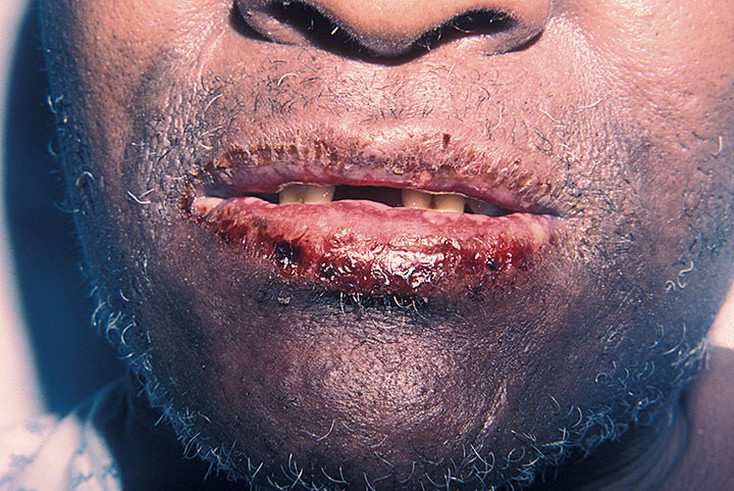
Types of allergic rashes
In most cases, allergic rashes have several types, which are characterized by an inflammatory process.
Types of primary rash that are a symptom of the development of a skin disease:
- Erythema– redness of the skin, which occurs due to excessive blood filling of the vessels.
- Papule- flat, dense formation.
- Vesicle– formation with transparent or cloudy contents.
- Acne– inflammation of the follicle with purulent contents.
Treatment
Treatment of an allergic rash may involve one or more methods, which include the following:
- Allergen elimination, which involves eliminating exposure to the allergen. If the allergen is a food product, then a specialist will prepare a special diet for the patient. However, this method will not be relevant if the allergen is dust or pollen.
- Immunotherapy involves injecting microdoses of the allergen. There are also special drops that are dripped under the tongue. This method is designed for long-term treatment.
- Medications in the form of ointments and medications for oral administration.
It is worth paying attention to the fact that many antihistamines and topical medications are contraindicated in pregnant women. In this case, the attending physician must select an alternative treatment.
Antihistamines
For allergic rashes, a specialist may prescribe the following antihistamines:
- Gistan.
- Allertek.
- Fexadine.
- Diphenhydramine.
- Astemizole.
All of the listed drugs should be prescribed by a doctor only after a special examination and passing all necessary tests. Otherwise, it may lead to a more severe allergic reaction to the medications.
Ointments
Antihistamines are often prescribed in combination with ointments or creams. Local treatments are divided into two types: hormonal and non-hormonal.
Hormonal drugs for local therapy:
- Prednisolone.
- Afloderm.
- Momat.
Non-hormonal drugs for local therapy:
- Fenistil-gel.
- Levomekol.
- Panthenol.
- Solcoseryl.
Conclusion
An allergic rash is the main symptom of allergic dermatosis. At the first symptoms, you should seek help from a medical facility., since some allergic diseases can be fatal if treatment is not started in time. But today there are many medications that help get rid of unpleasant symptoms.
An allergy is a reaction of the body to the influence of certain factors.(allergens).
One of the common symptoms is skin rashes due to allergies (photos are presented at the end of the article). This article will look at some types of allergic rashes, their causes and treatment.
Skin rash due to allergies is not permanent, It can occur either instantly or after a few days.
The causes of rashes can be very diverse, but Dermatologists highlight the impact of the following main factors:
- some types of medications;
- insect bites;
- food products (citrus fruits, honey, chocolate, dairy products);
- animal fur;
- pollen of some plants;
- cosmetics;
- household chemicals;
- some types of metals, even metal parts of clothing;
- natural factors.
It should also be added that skin rashes due to allergies, photos of which are presented in this article, can appear in a person even from exposure to frosty air or direct rays of the sun. 
Allergy skin rashes (photos below) manifest themselves in several forms: Quincke's edema, eczema, atopic dermatitis, and urticaria.
Skin rashes due to urticaria
Urticaria gets its name because its rashes are very similar to nettle burns. It relates more to a symptom than to an independent disease.
There are two types of urticaria:
- acute, lasting several weeks;
- chronic, lasting for several years.
- The manifestations of urticaria on the skin can be influenced by both internal and external factors. Some diseases (diabetes mellitus, infectious diseases, hepatitis, herpes, gastritis), as well as weakened immunity and certain foods can provoke such a rash.
Skin rashes caused by hives (a sign of an allergy) look like small spots or blisters, which can be seen in the photo provided. This rash may go away in a couple of hours and then reappear after a while. 
The blisters are filled with fluid and are clear in color., and the skin around the blister has a soft pinkish color. If treatment is not started on time, the rash can spread throughout the person’s body.
Rash due to atopic dermatitis
Atopic dermatitis is one of the allergic diseases, which mainly begins to manifest itself in childhood(up to 3 years).
The main cause of this disease is food allergens.
Atopic dermatitis is divided into 3 types:
- easy;
- average;
- heavy.
With mild atopic dermatitis, isolated rashes appear on the skin of a pale pink color. The itching is very mild and does not bother the person.
With average, numerous rashes appear throughout the body and itching increases. 
In severe atopic dermatitis, skin rashes appear in the form of deep ulcers on the body, itching brings anxiety and insomnia to the person.
With atopic dermatitis, dryness and flaking appear on the skin. Red spots of different sizes appear; when combing these spots, weeping wounds form. Most often, such rashes appear on the face (cheeks and temples), as well as on the bends of the knees and elbows.
Allergies associated with contact dermatitis
Contact dermatitis is the appearance of inflammatory processes on the skin of an individual caused by exposure to an allergenic irritant.
Skin rashes due to contact dermatitis (a type of allergy) can easily be confused with rashes of another origin (photos are presented below). 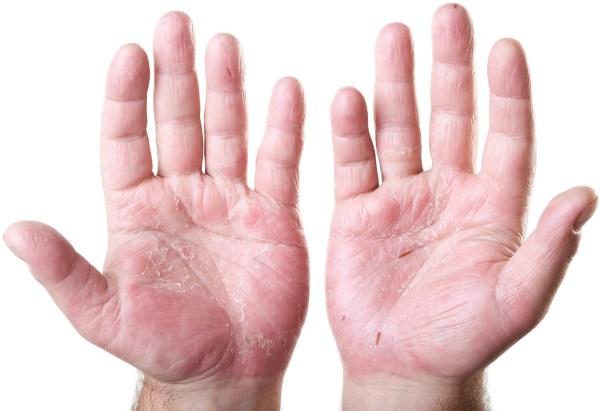
It is important to know! The first allergic signs of contact dermatitis do not appear immediately, but after a couple of hours or even after a few days. This feature makes it difficult to identify the allergen.
The rash begins to appear in those places that are in direct contact with the irritant(for example, an allergy to detergent: when washing dishes without protective gloves, an allergic rash begins on the hands).
Before the rash appears, severe itching of the body first appears., then the skin turns red and swells. Bubbles form at the site of redness. Small ulcers form in place of the bubbles; after a while they become covered with a dry crust.
Contact dermatitis rashes have clear contours and can be of different sizes. 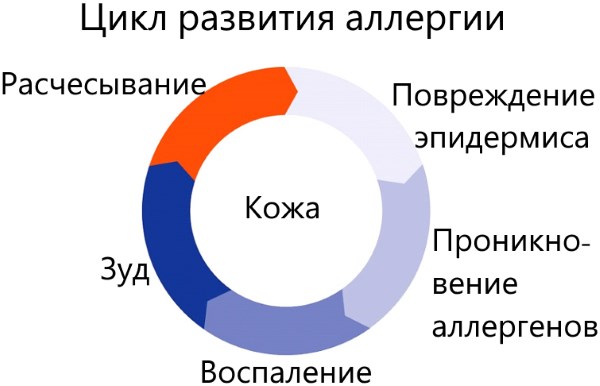
Eczema is an acute form of dermatitis
The acute form of eczema appears suddenly and develops very quickly.
It has 6 stages of development:
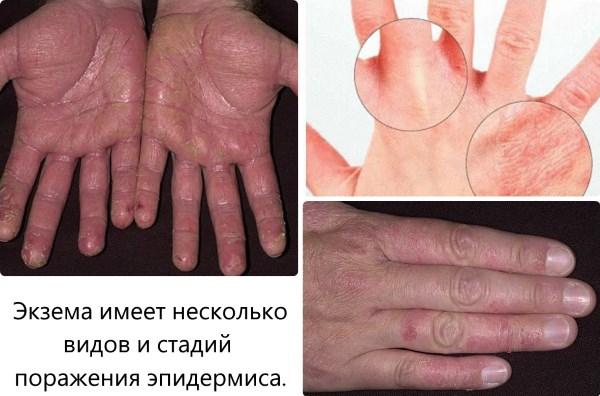
Important to remember! Skin rashes with acute eczema (photos allow us to better understand this type of allergy) appear not only from irritants, it can be caused by stress or severe emotional shock.
When the inflammatory process completely passes, the skin regains its previous appearance. With proper treatment, there will be no trace of ulcers on the body.
Allergic rash due to Quincke's edema
Quincke's edema is a dangerous allergic reaction of the body. It has another name - giant urticaria. Like any type of allergy, angioedema is provoked by irritants.
Skin rashes with such allergies (photos presented in this article) immediately turn into swelling.
The allergic reaction in question can be recognized by the following signs:

Note! When the internal organs become swollen, a person experiences severe abdominal pain, causing vomiting. In the absence of medical intervention, Quincke's edema can lead to serious consequences.
Rash due to neurodermatitis
Neurodermatitis is a common skin disease that greatly weakens the human immune system. Multiple rashes are a hallmark from other types of allergies.
Skin rashes due to neurodermatitis (allergies) affect the entire body in the form of small pimples (this can be seen in the photos presented). Over time, nodules appear and begin to merge into a common spot.
The affected skin has a pronounced red color. Increased peeling of the skin appears, scales form, and cracks appear in the affected areas. The body begins to itch very much. 
Treatment of skin rashes
To avoid serious consequences, any allergic rash begins to be treated immediately. There is not only drug treatment, but also folk recipes. Before use, it is recommended that you carefully familiarize yourself with any type of treatment.
Drug treatment
Drug therapy is prescribed only by a doctor: for children and adults, dosages, forms of release of drugs, and course of treatment will differ.
Antihistamines reduce the release of free histamine into the blood(available in the form of tablets, liquids for injections), these include the following drugs: Fenistil, Suprastin, Zyrtek, Diphenhydramine, Diazolin and many others.
It's worth knowing that they differ in their effects on the body: the more modern the drug, the fewer unwanted effects. 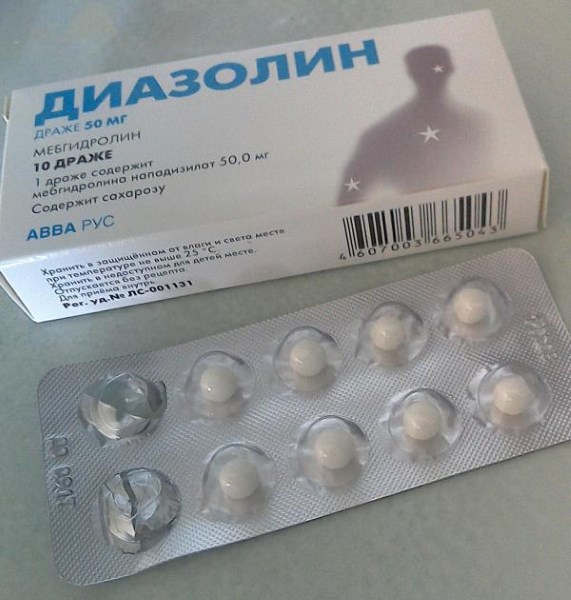
Ointments and creams that act locally on the rash- these include such as “Fenistil-gel”, “Prednisolone”, “Bepanten”.
Sorbents are used to quickly remove allergens from the human body.(“Smecta”, “ Activated carbon", "Polysorb").
Traditional recipes for fighting allergies
Usage traditional treatment allergies must be careful not to provoke a worsening of the condition.
Among the traditional medicines are the following:

If skin rashes appear, First of all, they find what exactly triggered the allergy and only after that they begin to treat her. For any allergic rash (this article contains photographs different types allergies) consult a doctor.
The skin is the largest human organ and it is not surprising that in the process of diseases occurring inside the body, side effects in the form of various kinds of rashes appear on the skin. Any symptom requires careful consideration; in this article about skin rashes in adults, we analyze the causes with photos, help you identify the culprit of the rashes, and also consider diseases, the early symptoms of which are often skin manifestations.
Since skin rashes are the first sign of many diseases, this signal cannot be ignored; any suspicious rash that suddenly appears should be examined by a qualified doctor (dermatologist, allergist or therapist), since the disease in a weakened form can manifest itself as skin changes, without additional symptoms.
A rash may indicate:
- Immune system problems.
- Gastrointestinal diseases.
- Allergic reactions.
- Problems with the nervous system caused by stress.
So what is a skin rash?
It is generally accepted that a rash is caused by changes in the skin and (or) mucous membranes. Changes may include primarily changes in color, texture of the skin surface, peeling, itching in the red area and pain.
The rash can be localized in completely different places on the body, for different types of rash there are typical places of appearance, for example, rashes associated with allergic reactions most often manifest themselves on the hands and face, while manifestations on the surface of the body are more often associated with infectious diseases.
Remember, scratching the rash is unacceptable in any case, this will lead to even greater skin irritation and the possible formation of ulcers.
Types of rash
Skin rashes may have different kind, but are always divided into two types:
Primary- occur in areas of healthy skin or mucous membranes due to pathological processes in the body.
Secondary– arise at the site of the primary ones for certain reasons (for example, lack of treatment)
By far the most favorable from the point of view of diagnostic possibilities and subsequent successful therapy are primary protrusions. All performances vary external signs such as size, shape, content, degree of coloring, grouping, etc.
Let's look at the main types of performances
Spot– Manifested by changes in skin tone or redness. It occurs in diseases such as syphilitic roseola, vitiligo, dermatitis, and birthmarks and freckles are also included in this type of manifestation.
Blister– Swollen redness with smooth edges, can be of regular or irregular shape, common causes of appearance: urticaria, insect bites, toxicoderma, usually does not require special treatment.
Pustule- a formation filled with pus in the layers of the epidermis, divided by type into superficial and deep. Accompanying diseases such as acne, impetigo, furunculosis, ulcerative pyoderma.
Nodule– can be found in all layers of the skin, externally it looks like a change in the surface of the epidermis with redness and a difference in density from the surrounding tissues, usually ranging in size from 1 to 10 mm. Typical manifestations of the nodule are caused by: psoriasis, several types of lichen, eczema, papillomas, various warts.
Allergy rash
The reason for the constant skin itching and visible rashes on the skin are often allergies; this is a fairly common occurrence nowadays, about 70 percent of people are somehow susceptible or have experienced allergic reactions.
What is an allergy? This is an aggravated reaction of the human immune system to an allergen that has entered the body, while in the process of getting rid of the presence of the allergen, a person’s blood vessels dilate, histamine is produced in large quantities, and redness, inflammation, swelling, and skin itching are almost always added to the above symptoms.
Attention! In the event of an acute allergic reaction with the formation of edema, the patient should immediately call an ambulance!
Allergic dermatitis also often manifests itself - when exposed to an allergen, a rash area forms at the point of contact, for example, when reacting to clothing - rashes in the waist, back and those places on the body where clothing fits most tightly to the skin, or when reacting to perfume or deodorant – in the area of greatest contact with the substance (often under the arms)
For a mild allergic reaction, the symptoms resemble those of colds: runny nose, possibly increased saliva and watery eyes. If you experience symptoms such as dizziness, tachycardia, convulsions and nausea, this may indicate a severe allergic reaction in which there is a risk of developing anaphylactic shock, you should immediately consult a doctor.
Allergies can be caused by:
- Pet hair
- Plant pollen in summer or autumn
- Medications
- Food products (chocolate, milk, citrus fruits, etc.)
- Various nutritional supplements
- Substances contained in perfumes or household chemicals
- Substances that make up wardrobe items (fabric, metals, dyes)
Rash due to infectious diseases
Rashes in infectious diseases are often characterized by stages of appearance, first it appears in one place, then in another, also for each infection there are typical places for rashes, a specific shape and size, it is important to remember all the details and, when interviewing, report all this information to the doctor.
Below we look at rashes associated with various infectious diseases:
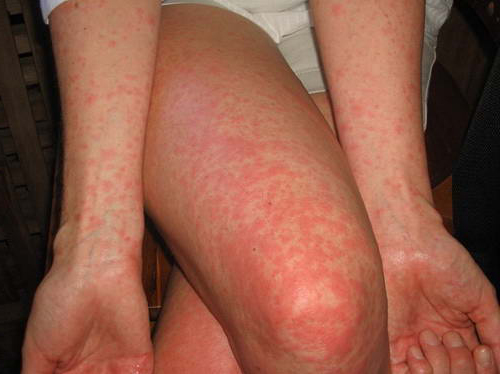 Rubella– in the initial stage of the disease, a small rash appears on the face and neck, then within 2 to 6 hours the rash spreads throughout the body. Usually appears as round or oval redness ranging from 2 to 10 mm in size. Remains on the skin for up to 72 hours, then disappears without visible traces. If you find yourself with a similar rash, you need to consult and examine a doctor, since similar rashes are symptoms of many infectious diseases. We also recall that rubella poses a particular danger to pregnant women, since if the mother is ill, the infection can harm the fetus.
Rubella– in the initial stage of the disease, a small rash appears on the face and neck, then within 2 to 6 hours the rash spreads throughout the body. Usually appears as round or oval redness ranging from 2 to 10 mm in size. Remains on the skin for up to 72 hours, then disappears without visible traces. If you find yourself with a similar rash, you need to consult and examine a doctor, since similar rashes are symptoms of many infectious diseases. We also recall that rubella poses a particular danger to pregnant women, since if the mother is ill, the infection can harm the fetus.
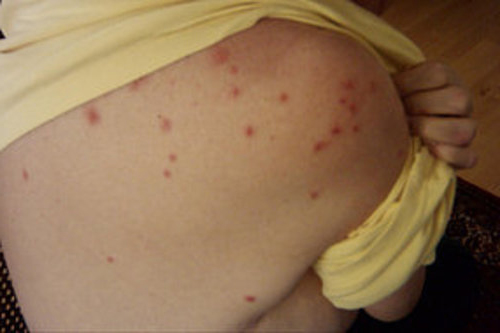 Measles– measles disease usually manifests itself with catarrhal manifestations. The rash appears after 2-7 days. The primary places of protrusion are on the skin of the nose and behind the ears, then within 24 hours it spreads to the skin of the chest, face, then the arms and neck also become covered with rashes. After 72 hours, the rash also covers the legs; the rash is most often intense and confluent. After the active phase of the disease, the rash changes color and forms something like pigment spots.
Measles– measles disease usually manifests itself with catarrhal manifestations. The rash appears after 2-7 days. The primary places of protrusion are on the skin of the nose and behind the ears, then within 24 hours it spreads to the skin of the chest, face, then the arms and neck also become covered with rashes. After 72 hours, the rash also covers the legs; the rash is most often intense and confluent. After the active phase of the disease, the rash changes color and forms something like pigment spots.
Chicken pox– with the onset of the disease it manifests itself as red spots, then bubbles with a red ring and liquid inside appear, similar in appearance to dewdrops. After two days, the outer surface of the bubble collapses and becomes less elastic. Subsequently, the blisters become coarse, crust over and disappear within seven days without leaving any visible traces.
Scarlet fever- Rashes with scarlet fever appear 24 hours after infection, the areas of active manifestations are the back, groin, elbow and knee bends, and armpit skin. Then inflammation appears on the skin, sometimes there is a slight blue discoloration in the places where roseola forms. The face with scarlet fever is usually not affected by a rash.
Let's look at the reasons with photos:
Rashes caused by infection:
Herpes– a scattering of small transparent bubbles of regular shape forms on the surface of the skin of the face and lips, then within 72 hours the bubbles become cloudy, dry out with the formation of darkish or gray-yellow crusts.
Warts– the skin of the extremities is usually affected; they look like dense, rough, irregularly shaped formations of a grayish color.
| Warts on the hand |
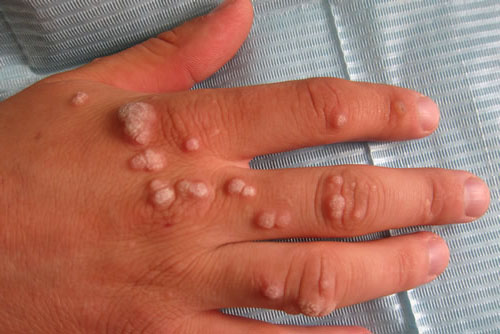 |
Syphilis– the appearance of rashes generally always accompanies secondary syphilis; the rash is almost always varied in the visual signs of the elements and their number on the patient’s skin. Typically, a syphilis rash is not accompanied by any additional sensations or unpleasant effects, and after disappearance there are no traces left on the skin. Secondary syphilis is accompanied by spotty rashes, which are characterized by a symmetrical arrangement, brightness and abundance. After 60 days, the rash usually goes away, after some time the rash appears again, not as abundant, more dull in color, localized in places of skin trauma, between the buttock muscles, in the groin, on the shoulders and on the chest.
Candidiasis– (yeast diaper rash) the usual places of manifestation are in the area of folds of the skin, folds of the abdomen, most often affects people with overweight, the first stage of the disease is accompanied by small blisters and pustules, which, when bursting, transform into wet erosions of a reddish-brownish color, which tend to merge. Cracks and accumulations of whitish, mushy tissue form on the surface of the patient's skin.
| Candidiasis |
 |
Pityriasis rosea– at the beginning of the disease, a red-pinkish spot appears on the skin of the chest and/or back with peeling in the central part, after which a spot-like rash of usually symmetrical shape forms on other parts of the body.
Shingles– manifests itself in the initial period as a group of blisters up to 50 mm, localized on one side of the chest, abdomen, head or shoulder; when they appear on the affected area, sensitivity worsens, accompanied by pain; after the blisters disappear, areas of hyperpigmentation and/or scars remain on the skin.
Lichen planus- usually the rash appears in the form of clusters of nodules and forms lines, rings or arcs on the skin with equidistant elements. Common sites of injury: trunk, inner surface limbs, genitals. The disease causes itching.
Molluscum contagiosum– shiny bubbles with smooth walls, translucent with a typical inclusion of pinkish, reddish or yellow colors in the center, with sizes from 2 to 10 mm. Upon palpation, white mushy contents are released.
Rubrophytia– a disease of a fungal nature, in one hundred percent of cases a person’s feet are affected, at the initial stage it is keratinization and peeling of the skin between the 3rd and 4th toes; during the course of the disease, manifestations in the form of erosion and blisters are possible; if the disease develops, the entire surface of the foot is affected.
Athlete's inguinal– skin lesions are usually in the area of folds in the groin (locations may vary). In the initial stage of the disease, spots of a reddish hue of regular shape and with an unchanged surface appear. As the disease progresses, the heel usually merges and forms a lesion on the skin with scalloped borders. The main area of the lesion is covered with crusts, erosions and scales.
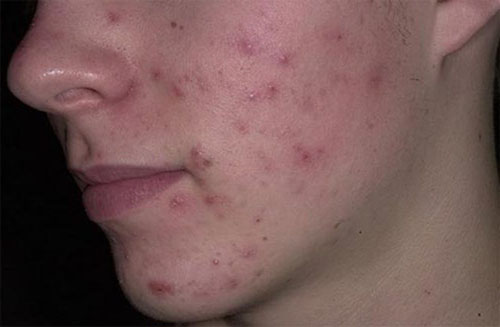
Lupus erythematosus– manifests itself primarily in open areas of the body: the upper body, face, head, neck; skin changes are often noticeable on the cheeks and bridge of the nose, shaped like a butterfly with wings.
Vitiligo– white spots of various shapes and sizes become noticeable on the skin; the spots may merge into one.
Solar keratosis– formed as a result of excessive exposure to sunlight on unprotected skin, looks first as redness then as a keratinized dry crust, affects mainly older people; if not treated promptly, carcinoma (skin cancer) can develop
Psoriasis– characterized by the appearance large quantity bright pink papules covered with scales, the number of papules increases as the disease progresses, they merge into large plaques, most often the rash at the initial stage appears in the area of the bends of the elbows and legs, as well as on the head.
| Psoriasis |
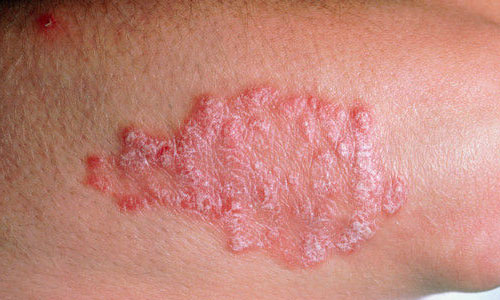 |
Allergic rash is a phenomenon that affects people of the most different ages due to increased sensitivity to certain substances. They can be food, drinks, plants and even physical objects (for example, the sun). It is important for each person to know exactly what allergens are present in his case and how to determine that an attack has begun.
The first signs of allergies in adults
In an adult, the first signs of an allergy can be varied - they depend on the strength of the substance, the general condition of the human body and other health characteristics. An attack may begin with sneezing, which is a natural reaction for the body, because in this way it gets rid of irritating substances. Symptoms associated with this should be considered nasal congestion, runny nose, and coughing.
In addition, adults may experience redness in the eye area and even more active production of tears. A characteristic feature of exposure to allergens on the body or thigh is that itching affects the right and left sides. Next you need to pay attention to:
- shortness of breath and the appearance of whistles during the respiratory process, which, with constant contact with allergens, turn out to be extremely loud;
- attacks of suffocation - they can be combined with a cough and even the discharge of white sputum in an adult if a strong dust allergen appears;
- itching of the skin on the back or side, small rashes, redness and other changes on the skin, in particular blisters.
The consequences of allergies, represented by the latter, can manifest themselves in completely different ways, for example, with hives, the rashes are not distributed symmetrically. Quincke's edema (a severe allergic reaction) is swelling of the face or any other parts of the body. Taking this into account, it is strongly recommended to find out everything about exactly what a particular rash on the body looks like, including red, if.
What does an allergic (red) rash on the body look like?
Allergic rashes, which appear as a rash on the surface of the body, differ in color from the normal skin. Most often they are large or smaller spots that will be located on the stomach, chest, limbs - almost anywhere. Speaking about classic hemorrhagic spots, it should be noted that they are a reddened area that does not protrude above the skin level.
In an adult, the physical signs associated with a body rash may vary. In the vast majority of cases, we are talking about urticaria, during the development of which spots on the body or back quickly change their shape and location and become very itchy. Food allergies are most often associated with a small rash of a mild red hue, but a likely consequence in the absence of correct treatment may be Quincke's edema.
Hemorrhagic rash (allergic spots)
The symptoms of hemorrhagic rash in adults deserve special attention. It is strongly recommended to pay attention to the fact that it is traditionally located at the level of the epidermis. It is probably located in the papillary layer. This type of rash is formed due to damage to the vascular walls by an infectious agent or certain immune complexes. It is as a result of this that a certain amount of blood on the skin is removed from the blood vessels from the cells.
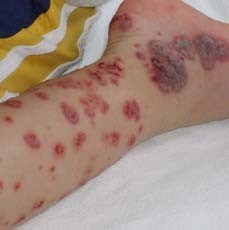 When applying pressure, such a rash does not disappear, and its shade does not change. Like all other types of spots, hemorrhagic spots are located at the level of the integument, without rising above it. Depending on the size of the areas and the components of the hemorrhagic rash, several varieties are distinguished:
When applying pressure, such a rash does not disappear, and its shade does not change. Like all other types of spots, hemorrhagic spots are located at the level of the integument, without rising above it. Depending on the size of the areas and the components of the hemorrhagic rash, several varieties are distinguished:
- petechiae is a point element that may not even be visible to the naked eye, even a child’s;
- purpura - up to one cm, for example, on the back;
- ecchymosis (bruise) - more than three mm in size, reminiscent of chickenpox.
The causes of a hemorrhagic small rash on the skin can be various factors, for example, the use of certain medications or infectious diseases.
Popular causes and types of allergic rashes in adults
An allergic rash can appear due to various factors, for example, there is an allergy to bananas, chicken or citrus fruits, and alcohol. In addition, an equally rare physiological reaction is the occurrence of skin changes due to the sun or alcohol.
Tip: In order to distinguish between these reactions, it is important to know everything about how they manifest themselves and look.
Allergy to bananas
An allergic reaction to bananas in adults can be quite rare. Among all the most common allergens, the presented fruit is classified as a medium allergen. It can provoke specific cross-reactions that extend to other names, for example, peaches or watermelons.
A reaction to bananas can manifest itself as significant itching of the skin of the body, which will subsequently spread to the oral cavity, larynx and lips, and back. Among the main manifestations, dysfunction of the digestive system is identified, namely abdominal pain, diarrhea and vomiting.
Some adults with banana poisoning may experience a prolonged runny nose, swelling of the mucous membrane of the mouth or even nose, rash and numerous rashes. The attack is relieved through the use of antiallergic drugs; in more complex cases, gastric lavage is used. Prevention of the condition involves eliminating bananas from the diet. It is advisable to give up alcohol.
For chicken meat
Not everyone can consume chicken meat calmly and without the risk of developing allergies. Most often, such reactions are inherited. The most active provocateurs of such reactions are components called purines. They are the ones who influence the formation of such symptoms: redness, which can form in one place or spread over the entire surface of the body. In addition, experts pay attention to:
- acquisition of significant wateriness in the whites of the eyes;
- swelling of not only the tongue, but also the lips;
- redness in the eye area or itching near the eyelashes.
An allergy to chicken or can provoke itching, in which the whole body itches and tingling in the inside of the mouth. It should further be noted that some people may experience respiratory or, for example, gastrointestinal symptoms, namely coughing, minor sneezing, nausea or vomiting. To stop an attack, antihistamines are used; in more severe cases, gastric lavage is used.
For citrus fruits
 In adults, allergies to citrus fruits are quite rare; in the vast majority of cases, this is typical for children. Experts note that this can be influenced not so much by the substances contained in the oranges or grapefruits themselves, but by the chemical components with which they are treated - biphenyl, fungicides and many others. Manifestations can be very different: from allergic enterocolitis to an asthma attack or allergic stomatitis. In the most severe situations, anaphylactic shock is likely to develop, which can only be treated in a hospital setting.
In adults, allergies to citrus fruits are quite rare; in the vast majority of cases, this is typical for children. Experts note that this can be influenced not so much by the substances contained in the oranges or grapefruits themselves, but by the chemical components with which they are treated - biphenyl, fungicides and many others. Manifestations can be very different: from allergic enterocolitis to an asthma attack or allergic stomatitis. In the most severe situations, anaphylactic shock is likely to develop, which can only be treated in a hospital setting.
When consuming citrus fruits, the patient is recommended to be prescribed antihistamines, and if the condition is aggravated, hormonal drugs are recommended. Enterosorbents must also be prescribed, allowing the intestines to be treated as well.
In the sun
Photodermatitis, or sun allergy, is a pathological condition, the occurrence of which is associated with an increased degree of sensitivity of the skin to sunlight. The leading symptoms of the disease should be considered redness and inflammation of the skin, its peeling. In addition, the skin of the back and other parts of the body may itch or even experience a burning sensation.
The most difficult processes are prevention and treatment, especially with severe reactions. For this purpose, special cream formulations and certain medications can be used: hormonal or immunomodulatory.
Red spots due to alcohol
 Photos of skin rashes due to allergies
Photos of skin rashes due to allergies Allergies to alcoholic beverages can have different symptoms, but most often we are talking about the formation of red spots. They are formed as a physiological response to impurities and additives in certain drinks. The body reacts to alcohol in this way much less often. Paying attention to the features of symptoms, I would like to note that:
- red spots on the skin are symptoms initial stage, which gradually turn out to be more and more complex;
- as the reaction develops, the spots merge and begin to form one whole, and the itching also intensifies;
- There is a deterioration in general well-being, and then a runny nose develops, as a result of which the nose can be very itchy.
Advice: Avoiding such an attack in adults is possible only by abstaining from drinking alcoholic beverages.
In cases where it is necessary to stop an allergic reaction, they resort to gastric lavage. Many people wonder what is urticaria?
For synthetics
Allergic reactions to synthetics occur quite often and they can occur not only in adults, but also in children. The main reasons for this are: mechanical irritation of the most sensitive areas of the skin of the body, back, as well as a reaction to dyes and chemical components used to process the fabric.
Symptoms of this include redness, rashes and peeling, and the skin in the affected area becomes very itchy. To treat this condition, it is recommended to stop wearing synthetic clothing. It is important to normalize your lifestyle by giving up bad habits. Speaking about drug treatment, attention is paid to the use of antihistamines, ointments and creams.
For electronic cigarettes
Electronic cigarettes cannot be considered much safer than regular cigarettes. They also contain aromatic additives, glycerin, propylene glycol and other ingredients that can cause allergies. The most active in terms of provoking allergies are those names that contain at least a minimal amount of nicotine. In any case, if a person experiences coughing or itching when interacting with them, it is strongly recommended that they stop using e-cigarettes. Otherwise, anaphylactic shock or various hemorrhagic reactions are likely, the treatment of which is problematic.
On the water
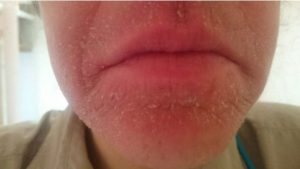 Water intolerance, namely aquagenic urticaria, is encountered extremely rarely. The reason for this reaction is not the water itself, but the additional components it contains. Additional factors should be considered aggravated immunity due to the use of antibiotic components, chronic kidney pathologies, as well as immunoglobulin deficiency.
Water intolerance, namely aquagenic urticaria, is encountered extremely rarely. The reason for this reaction is not the water itself, but the additional components it contains. Additional factors should be considered aggravated immunity due to the use of antibiotic components, chronic kidney pathologies, as well as immunoglobulin deficiency.
Symptoms of the condition include various skin changes: from micro burns on the back or rashes to irritation and significant dryness. Treatment is prescribed depending on the allergy symptoms in an adult and the specific type of substance, as is the case with alcohol.
On detergents on hands
Overwhelming majority detergents contains flavors, fragrances, alkalis and acids, as well as other components. That is why an allergic reaction on the skin of the hands is not uncommon. Paying attention to the symptoms, I would like to note:
- redness, severe irritation or even a small rash;
- peeling and itching;
- severe dryness up to the formation of bleeding cracks that will itch very much.
For the purpose of prevention, it is recommended to abandon the drug that provokes such negative reactions, as well as improve the condition of the skin and immune background. This will allow the body to show greater resistance to such allergens and help answer the question Is there an allergy to cold?.
For chlorine in the pool
The reaction to bleach manifests itself due to its active chemical composition, and it begins immediately after the composition penetrates the skin area. Symptoms may vary depending on the area of penetration of the component. For example, if we are talking about the eyes, it is redness and burning, if it is about the nasopharynx, then it is a cough or runny nose.
The most dangerous are its vapors, which can affect the entire surface of the human body. The treatment method may be solely prevention, completely eliminating any contact with bleach.
Advice: If it penetrates the skin in the pool, it is recommended to consult a dermatologist.
Hamster allergy symptoms
 Photo of red sipi on the body of an adult
Photo of red sipi on the body of an adult When noting symptoms of hamster allergy, they include itching in the eyes, runny nose and sneezing. Aggravated forms of such allergies in adults can provoke a dry cough, severe and prolonged wheezing, and difficulty in the respiratory process. In addition, all kinds of rashes on the skin and body, including hemorrhagic ones, are likely.
Symptoms of an allergy to deodorant
Symptoms of an allergic reaction to deodorant can manifest as various small rashes or redness. In addition, peeling of the skin, swelling, nasal congestion and even rhinitis can be identified. Sneezing and increased breathing should be considered no less pronounced symptoms.
For metal
After prolonged contact of the skin with the metal, the latter’s ions penetrate into human body through the upper layer of the epidermis. Due to this, there is a significant impact on chemical composition cells, which will give an active physiological response. Speaking about other reasons, experts pay attention to the chemicals present and their intolerance. Allergy symptoms manifest themselves in changes in the skin and an increase in temperature. Treatment will be most effective if you avoid contact with such metals.
For rubber gloves
In the vast majority of cases, such reactions occur on natural latex fibers. It is also obtained from the sap of the rubber tree, which provokes allergies. Its formation can be avoided by using vinyl or acrylic varieties. When coming into contact with such gloves, a person may experience a sore throat or itching, a runny nose, as well as irritation in the lip area, which will be very itchy. For effective treatment, it is recommended to use antiallergic tablets or cream formulations.
FAQ
Does allergies cause fever or not?
A slight increase in temperature when an allergic component enters the body can be considered normal. Thus, a signal is given that a foreign object has penetrated the cells. A change in temperature of more than one degree should be considered a much more alarming symptom. This indicates the addition of inflammation, and therefore in this case a separate recovery course is prescribed.
What is the name of the allergy blood test?
A blood test for allergies is a test of the blood for the content of immunoglobulin E. Depending on the specific food or other allergens, different indices of this component are identified.
What to apply to an allergic rash?
To ensure effective treatment of allergic rashes, the following remedies are used:
- non-hormonal ointments, for example, Fenistil or Bepanten;
- hormonal compounds, namely Advantan or Elokom;
- Fluorocort, Afloderm and others, used for significant allergic and inflammatory reactions.
The most potent components are ointments Galcinonide, Dermovate, the use of which would be best discussed with a specialist. In addition, the treatment of allergies in an adult on the skin can be carried out using Levomekoli, Panthenol and other agents that are more likely to be preventive.
Can you be allergic to coffee?
 Instant or brewed coffee is a fairly strong allergen. In the vast majority of cases, the reaction manifests itself in vomiting, severe abdominal pain and frustration. Less commonly, skin changes such as rash or itching may occur. The most rare symptoms are an increase in temperature, as well as Quincke's edema.
Instant or brewed coffee is a fairly strong allergen. In the vast majority of cases, the reaction manifests itself in vomiting, severe abdominal pain and frustration. Less commonly, skin changes such as rash or itching may occur. The most rare symptoms are an increase in temperature, as well as Quincke's edema.
How to find out what an adult is allergic to?
To determine a specific allergen, specialized tests are used to identify even the rarest species. In the vast majority of cases, skin tests or blood tests for immunoglobulin E are used. It is recommended to use them all together, which will increase the accuracy of the studies, for example, if a reaction to mascara or shellac is formed.
What could you be allergic to in October?
Allergies in mid-autumn, namely in October, can develop due to three factors. When talking about this, people pay attention to pollen, fungal spores and house dust. It should be borne in mind that it is in October that quinoa, wormwood and ragweed bloom, as a result of interaction with which a rash, swelling of the throat and no less serious symptoms can occur. Some of them are directly related to How does a sweet allergy manifest?.
Allergy to milk, is it possible to have fermented milk products?
Fermented milk products can also not be consumed by everyone, because, for example, cow’s milk contains at least 20 components that have different protein natures. Lipoproteins and alpha-lactalbumin deserve special attention in this regard. This is why if an adult begins to sneeze or cough after eating dairy products, it is recommended that they undergo a special check.
Allergy to hair dye, what to do?
Tip: If women are allergic to hair dye, it is recommended to rinse their hair with a herbal decoction, such as chamomile.
If burning and itching occurs in the face or neck, apply the following compositions to the affected area of skin: Fenistil-gel or Psilo balm. Antihistamines are used if a person's condition quickly worsens or if they begin to itch excessively. If symptoms and fever do not go away within several hours, it is recommended to seek medical support.





